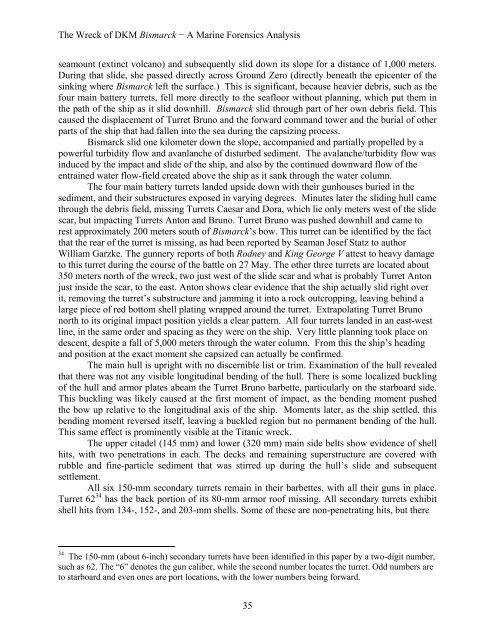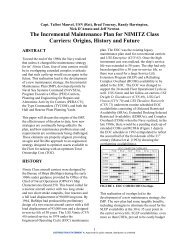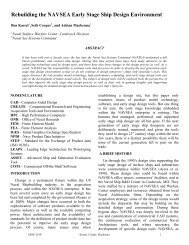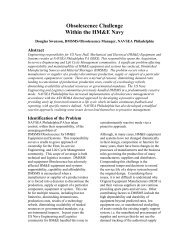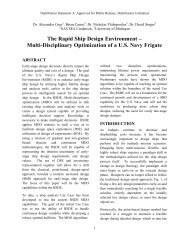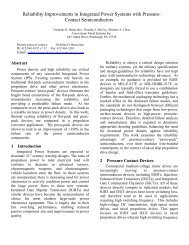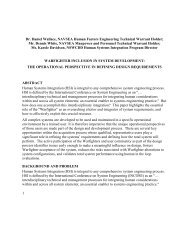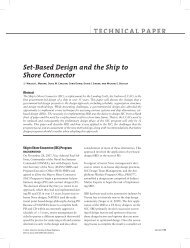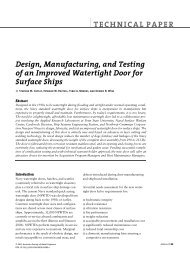The Wreck of DKM Bismarck − A Marine Forensics Analysis 1 The ...
The Wreck of DKM Bismarck − A Marine Forensics Analysis 1 The ...
The Wreck of DKM Bismarck − A Marine Forensics Analysis 1 The ...
Create successful ePaper yourself
Turn your PDF publications into a flip-book with our unique Google optimized e-Paper software.
<strong>The</strong> <strong>Wreck</strong> <strong>of</strong> <strong>DKM</strong> <strong>Bismarck</strong> <strong>−</strong> A <strong>Marine</strong> <strong>Forensics</strong> <strong>Analysis</strong><br />
seamount (extinct volcano) and subsequently slid down its slope for a distance <strong>of</strong> 1,000 meters.<br />
During that slide, she passed directly across Ground Zero (directly beneath the epicenter <strong>of</strong> the<br />
sinking where <strong>Bismarck</strong> left the surface.) This is significant, because heavier debris, such as the<br />
four main battery turrets, fell more directly to the seafloor without planning, which put them in<br />
the path <strong>of</strong> the ship as it slid downhill. <strong>Bismarck</strong> slid through part <strong>of</strong> her own debris field. This<br />
caused the displacement <strong>of</strong> Turret Bruno and the forward command tower and the burial <strong>of</strong> other<br />
parts <strong>of</strong> the ship that had fallen into the sea during the capsizing process.<br />
<strong>Bismarck</strong> slid one kilometer down the slope, accompanied and partially propelled by a<br />
powerful turbidity flow and avanlanche <strong>of</strong> disturbed sediment. <strong>The</strong> avalanche/turbidity flow was<br />
induced by the impact and slide <strong>of</strong> the ship, and also by the continued downward flow <strong>of</strong> the<br />
entrained water flow-field created above the ship as it sank through the water column.<br />
<strong>The</strong> four main battery turrets landed upside down with their gunhouses buried in the<br />
sediment, and their substructures exposed in varying degrees. Minutes later the sliding hull came<br />
through the debris field, missing Turrets Caesar and Dora, which lie only meters west <strong>of</strong> the slide<br />
scar, but impacting Turrets Anton and Bruno. Turret Bruno was pushed downhill and came to<br />
rest approximately 200 meters south <strong>of</strong> <strong>Bismarck</strong>’s bow. This turret can be identified by the fact<br />
that the rear <strong>of</strong> the turret is missing, as had been reported by Seaman Josef Statz to author<br />
William Garzke. <strong>The</strong> gunnery reports <strong>of</strong> both Rodney and King George V attest to heavy damage<br />
to this turret during the course <strong>of</strong> the battle on 27 May. <strong>The</strong> other three turrets are located about<br />
350 meters north <strong>of</strong> the wreck, two just west <strong>of</strong> the slide scar and what is probably Turret Anton<br />
just inside the scar, to the east. Anton shows clear evidence that the ship actually slid right over<br />
it, removing the turret’s substructure and jamming it into a rock outcropping, leaving behind a<br />
large piece <strong>of</strong> red bottom shell plating wrapped around the turret. Extrapolating Turret Bruno<br />
north to its original impact position yields a clear pattern. All four turrets landed in an east-west<br />
line, in the same order and spacing as they were on the ship. Very little planning took place on<br />
descent, despite a fall <strong>of</strong> 5,000 meters through the water column. From this the ship’s heading<br />
and position at the exact moment she capsized can actually be confirmed.<br />
<strong>The</strong> main hull is upright with no discernible list or trim. Examination <strong>of</strong> the hull revealed<br />
that there was not any visible longitudinal bending <strong>of</strong> the hull. <strong>The</strong>re is some localized buckling<br />
<strong>of</strong> the hull and armor plates abeam the Turret Bruno barbette, particularly on the starboard side.<br />
This buckling was likely caused at the first moment <strong>of</strong> impact, as the bending moment pushed<br />
the bow up relative to the longitudinal axis <strong>of</strong> the ship. Moments later, as the ship settled, this<br />
bending moment reversed itself, leaving a buckled region but no permanent bending <strong>of</strong> the hull.<br />
This same effect is prominently visible at the Titanic wreck.<br />
<strong>The</strong> upper citadel (145 mm) and lower (320 mm) main side belts show evidence <strong>of</strong> shell<br />
hits, with two penetrations in each. <strong>The</strong> decks and remaining superstructure are covered with<br />
rubble and fine-particle sediment that was stirred up during the hull’s slide and subsequent<br />
settlement.<br />
All six 150-mm secondary turrets remain in their barbettes, with all their guns in place.<br />
Turret 62 34 has the back portion <strong>of</strong> its 80-mm armor ro<strong>of</strong> missing. All secondary turrets exhibit<br />
shell hits from 134-, 152-, and 203-mm shells. Some <strong>of</strong> these are non-penetrating hits, but there<br />
34 <strong>The</strong> 150-mm (about 6-inch) secondary turrets have been identified in this paper by a two-digit number,<br />
such as 62. <strong>The</strong> “6” denotes the gun caliber, while the second number locates the turret. Odd numbers are<br />
to starboard and even ones are port locations, with the lower numbers being forward.<br />
35


